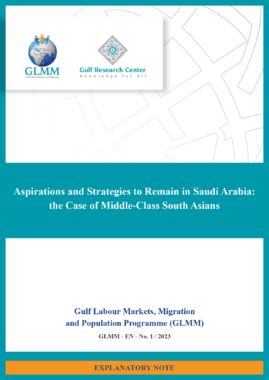GCC: Total population and percentage of nationals and non-nationals in GCC countries (national statistics, mid-2022)
| Country | Total population | Nationals | Foreign nationals | % nationals | % foreign nationals |
| Bahrain | 1,524,693 | 714,011 | 810,682 | 46.8 | 53.2 |
| Kuwait | 4,589,643 | 1,502,896 | 3,086,747 | 29.9 | 70.1 |
| Oman | 4,730,648 | 2,835,864 | 1,894,784 | 59.9 | 40.1 |
| Qatar | 2,878,202 | 348,839* | 2,529,362* | 12.1** | 87.9** |
| Saudi Arabia | 32,175,224 | 18,792,262 | 13,382,962 | 58.4 | 41.6 |
| UAE | NA | NA | NA | NA | NA |
| Source: National institutes of statistics and GLMM’s estimates based on data published by | |||||
| National Statistical Institutes (see below). | |||||
| * GLMM’s estimate, based on data published by National Statistical Institutes | |||||
| (see below). | |||||
| ** Ratio is calculated on the basis of population estimates (see below). | |||||
1- Definition:
Non-nationals are:
1- persons bearing nationality of a foreign State other than the GCC State of residence, or bearing no proof of nationality from any given state (stateless persons and holders of refugee status and travel document in a third country);
2- Holders of residence permit residing in the given GCC country at date of census, as per definition of residence used in each of the countries.
Figures by nationality for Qatar are author’s estimates.
2- Sources of data:
(1) Bahrain: Bahrain Open Data Portal, “Population” section,
https://www.data.gov.bh/pages/homepage/
Source: administrative records (central Population Register)
(2) Kuwait: Central Bureau of Statistics
https://www.csb.gov.kw/default_en
“Population” statistics, 01-01-2022 and 01-01-2023
The population estimates are based on the results of census 2021.
Kuwait population estimates: based on natural increase (births-deaths), and number of naturalisations during past year.
Non-Kuwaiti population estimates: based on natural increase, and on net migration (entries-exits) (Ministry of Interior data) recorded during the past year.
Source of births and deaths data: the Public Authority for Civil Information (PACI) (inaccessible from outside Kuwait as of December 2023).
The figure for mid-2022 (average of the two figures for 01 January) was calculated by the author.
(3) Oman: National Centre for Statistical Information (NCSI), census 2020 portal
https://portal.ecensus.gov.om/ecen-portal/
Dataset “Population”, updated figures for 01-01-2022 and 01-01-2023.
location of report: public/Census_reports/Public_Datasets/public_population_en.xanalyzer
The figure for mid-2022 (average of the two end-of-year figures) was calculated by the author.
(4) Qatar: Total figures of Qataris and non-Qataris residing in Qatar are not readily available in any published source. The present figures are GLMM’s estimates, using:
- Qatar Planning and Statistics Authority. The Annual Bulletin of the Labour Force Survey 2022
which gave:
- the numbers of Qataris and foreigners aged 15 and above for 2022;
- The total resident population in Qatar.
- Qatar Planning and Statistics Authority. Woman and Man in the State of Qatar-A Statistical Profile, 2022,
which gave:
- the sex ratio of the total population by nationality
- the percentage distribution of population by broad age group for mid-2021, by sex and nationality
(last available data on total national and foreign populations’ age structure, as of December 2023)
These were used to estimate the total population by sex and nationality.
(5) Saudi Arabia: General Authority for Statistics (GAStat) Statistical database, census 2022, Population estimates.
Report name: Population estimates by gender, nationality, and region 2010 – 2022
https://database.stats.gov.sa/home/report/3868
Indicator Definition: KSA Population revised and backcasted with 2022 census population as a base and historical administrative data applied.
Methodology:
(6) UAE: No figures of total (non-disaggregated) population available for 2022, as of December 2023;
Figures of UAE population disaggregated by nationality are unavailable in published sources. For estimates relevant to earlier years, please visit GLMM’s database:
https://gulfmigration.grc.net/glmm-database/demographic-and-economic-module/.
Last date of access: December 2023.
GLMM and GRC cannot guarantee that the link to access the source will not change; that the information will not be removed from the website it was obtained from; that no geo-blockages will be imposed; or that the information will not be available for any another reason.
Keywords: Bahrain, Oman, Kuwait, Saudi Arabia, Qatar, United Arab Emirates, Foreign & National Populations
Similar Posts:
- GCC: Population and percentage of nationals and non-nationals in GCC countries, by sex (national statistics, mid-2022)
- GCC: Total population and percentage of nationals and non-nationals in GCC countries (selected countries, national statistics, mid-2021)
- GCC: Total population and percentage of nationals and non-nationals in GCC countries (national statistics, 2020) (with numbers)
- GCC: Total population and percentage of nationals and non-nationals in GCC countries (national statistics, mid-2020)
- GCC: Total population and percentage of nationals and non-nationals in GCC countries (national statistics, mid-2020)
Tags: Bahrain, Foreign and National Populations, Kuwait, Oman, Qatar, Saudi Arabia, United Arab Emirates




